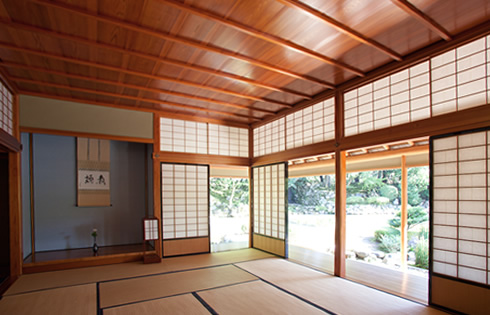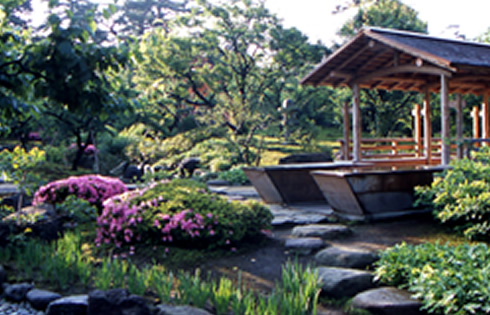

History
The changes Kenroku-en has gone through in the course of history
Before the garden was developed
Before the garden was developed various facilities were built by the line of lords of the Kaga Domain
Some time after Maeda Toshiie, the founder of the Kaga Domain made a triumphal entry into Kanazawa Castle in 1583, the family temple for the Maeda family named "Hoen-ji" and the place of their worship called "Hachaku-ji" were built on the flat land leading to Kodatsuno Plateau. Thirty years later, in 1620,these two temples were relocated to use the site for the residences for the seven old retainers of the Kaga Domain. Meanwhile around that time, on the terrace across from the castle the residence for Ohaku, the Ming scholar invited by the 2nd lord Toshinaga was built.
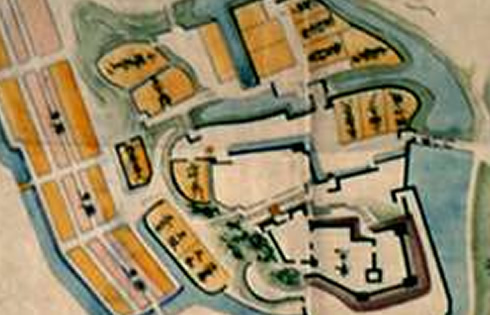
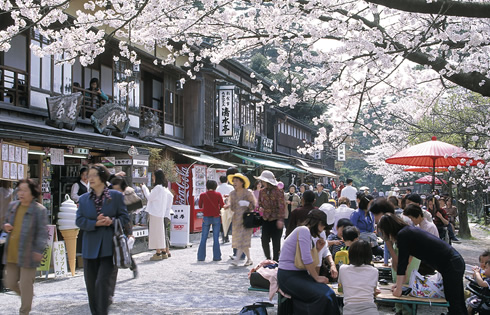
Before the garden was developed
Renchi-tei garden”was often enjoyed by the line of lords.
The development of Kenroku-en started with the terrace across from the castle. The 5th lord Tsunanori relocated the construction office back to the castle grounds to build a villa for himself on the site as well as developing the garden around it. This is said to have been the beginning of the garden development. The garden was called "Renchi-tei garden" at that time. The place was often used for different banquet occasions such as viewing the moon or enjoying colorful maples. The Renchi-tei garden was deeply loved by the line of lords and old retainers, but it was nearly burnt down except for only a small part by the great fires in 1759. It is the 11th lord Harunaga, who restored the garden. With Midori-taki waterfall and Yugao-tei tea house built in 1774 and Uchihashi-tei tea house in 1776, the development of the garden was nearly completed.
Chitose-dai going through changes with the different desires of the line of the lords
The upper flat land over the Renchi-tei garden is called "Chitose-dai." Chitose-dai went through busy changes by how the line of lords wanted to use the place.
In 1792, some time after the middle of the domain ruling, Harunaga built domain schools called "Meirindo" and "Keibukan." After Harunaga's death, his heir the 12th lord Narinaga relocated these schools to develop a retirement villa for himself called "Takezawa Goten" in 1822. In the same year, the name "Kenroku-en" was given to the place by Matsudaira Sadanobu, the lord of the Shirakawa Domain ruling the region in the northeastern Japan.
After Narinaga's death, the villa buildings with the great area of 13,224 square meters and with over 200 rooms were all torn down by his heir, the 13th lord Nariyasu. Complete clearing of the site was finished in 1851. By extending the pond and planting good-shaped trees and by integrating the Chitose-dai land with Renchi-tei garden, Nariyasu developed the garden to a greater one.
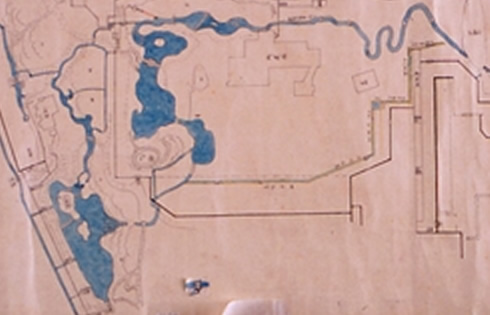
After Meiji Period
From the garden for the lords to that for the public
Kenroku-en was fully opened to the public in 1874. With that many tea houses opened as well. "Meiji Monument" was erected in the memory of the war dead sent to the battle, which took place in the southern Japan in 1880.
Kenroku-en was designated a National Site of Scenic Beauty in 1922. It was rated higher to a National Site of Special Scenic Beauty in 1985, thus gaining the most honorable rank equivalent to a National Treasure. In 1976 the free admission system implemented since Kenroku-en was opened to the public was stopped, and the entrance fee system had to be introduced to better manage the garden.
The "Hase-ike pond development program" was planned in 1994, and the development was completed in 2000. With this development "Shigure-tei" and "Funano-ochin" tea houses, which were torn down in the early Meiji Period were reconstructed. Two streams were also newly added to the garden, thus enriching the whole garden.
